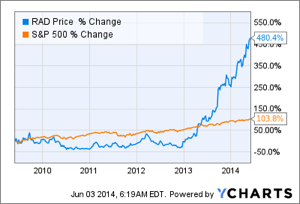Investors playing the Mar. 2013 breakout of Rite Aid Corporation (RAD) made huge capital returns of approximately 375% on a combination of its turnaround plan and investor expectations of favorable demographics. After a nearly four-year cap on the stock at $1.75 per share, RAD has been in a steep uptrend for approximately 18 months, recently making a new 52-week high last week. But, will the stock provide further returns in the coming months?
Macro Trends Strongly Favor Pharmacies
 Like its comparable rivals, CVS Caremark (CVS) and Walgreen Company (WAG), Rite Aid will benefit from strong and favorable trends in the marketplace. The Affordable Care Act (ACA) and the millions of aging baby boomers are two components of an expected rising customer base. While overall U.S. retail sales stagger from poor-to-no growth, sales of prescription drugs and affiliated items have countered the dismal trend in consumer discretionary spending.
Like its comparable rivals, CVS Caremark (CVS) and Walgreen Company (WAG), Rite Aid will benefit from strong and favorable trends in the marketplace. The Affordable Care Act (ACA) and the millions of aging baby boomers are two components of an expected rising customer base. While overall U.S. retail sales stagger from poor-to-no growth, sales of prescription drugs and affiliated items have countered the dismal trend in consumer discretionary spending.
Though the enactment of the ACA has financially stained many businesses (whose payrolls include more than 50 employees), the addition of eight million Americans to the rolls of the insured in the United States increases Rite Aid’s potential customer base by the same amount. That favorable statistic is in addition to the three million bump in the number of insured through the federal government’s expansion of Medicaid of last fall.
But the tsunami that’s historically provided huge revenue boosts to any business in its path, is, of course, will come from the largest demographic block of them all: baby boomers. Companies which sold to this dominate group automobiles in the 1960s, disposable diapers in the 1970s, new homes in the 1980s, and investment plans of the 1990s and 2000s, can tell you the firm upward bias effect this age group had on their revenue.
And of course, its no secret that millions of Americans each year (for the next 15 years) will reach 65-years-old, and they will need additional medications and medical care. On average, those between the ages of 65 and 74 purchase twice as much medication than the age 45 to 54 group. So, the market is not only expanding in the number of new customers throughout the next 15 years, the revenue per customer is expected to grow, as well.
Another Extended Patent Cliff Period on the Horizon
In addition to strong upward macro trend in the pharmacy market of expanded healthcare coverage for more Americans and the aging of baby boomers, the years of 2015-19 is a time period when approximately $88b worth of annual pharmaceutical revenue from patented drugs will drop to zero, according to Rite Aid’s 2014 investor presentation.
It appears the so-called ‘patent cliff’ that we heard of in 2012 will be back again in the coming few years, lifting “gross margins approximately 50% higher than branded drugs, for both wholesalers and retailers,” states Forbes in a recent article about the outlook of the pharmacy industry. And higher gross margin has historically shown to be a more reliable metric (than most other commonly-used financial metrics, e.g. forward P/E) when used to forecast future stock prices.
Rite Aid Shifts from Right-Sizing to a New Look and Expansion
In response to declining revenue, Rite Aid had embarked upon a store remodeling campaign. Of the approximate 4,500 locations, Rite Aid remodeled 1,200 stores.
The effort appears to have paid off. Rite Aid’s same-store sales of its remodeled stores rose 3% more, year-over-year, than stores which were not remodeled.
Emboldened by the marked improvement at its remodeled stores, Rite Aid has budgeted $180m and $225m to remodel additional stores in fiscal 2014 and 2015, respectively. Those budgets represent an additional remodeling budgets of 16.1% and 45.1% above the company’s 2013 budget, respectively.
After closing 38 stores in 2013 and 28 more in 2014, Rite Aid acquired RediClinic, a Texas-based chain of 30 clinics, operating in H.E.B. Grocery stores. The acquisition was cheered by investors, as the expanded footprint now reaching Texas is expected to boost revenue from the servicing of millions of retirees in that state. According to Rite Aid, 70 additional clinics will open by the close of the second quarter of 2016.
Conclusion
The big money in RAD has already been made from the company’s successful turnaround efforts. However, shares of Rite Aid still sell at a substantial discount to its competitors (see here). Though the Rite Aid remains in turnaround mode, its clear that the company’s management has proved its competency. The market climate in the coming years couldn’t not be much more favorable with the combination of mandated healthcare to more Americans and an aging population. Gross margin should continue to favor expansion, as revenue and substantially higher margins from generic drugs increases at the expense of lower-margin branded drugs throughout the remainder of the decade. Debt has been an issue for Rite Aid for several years, but the company has structured to postpone meaningful repayment commitments until year 2018.
Final thoughts
Rite Aid has come a long way in its turnaround. The company’s balance sheet is far better positioned thanks to its debt refinancing and cost cutting and its new Wellness store format is showing significant results. The company has remodeled more than 1,200 locations into the new format and front end same store sales at those locations grew more than 3% more than at non-remodeled stores during fiscal 2014. As the company transitions from a turnaround to a growth story, a combination of a more insured, older population and potential expansion into new markets could provide plenty of shareholder friendly tailwinds going forward.
Metric comparisons, PEG, et cetera

0 Comments